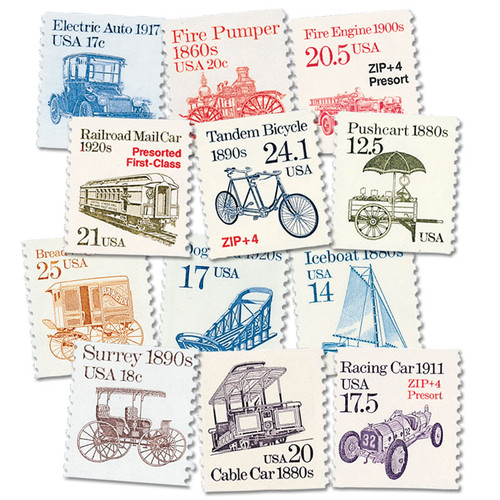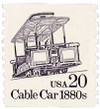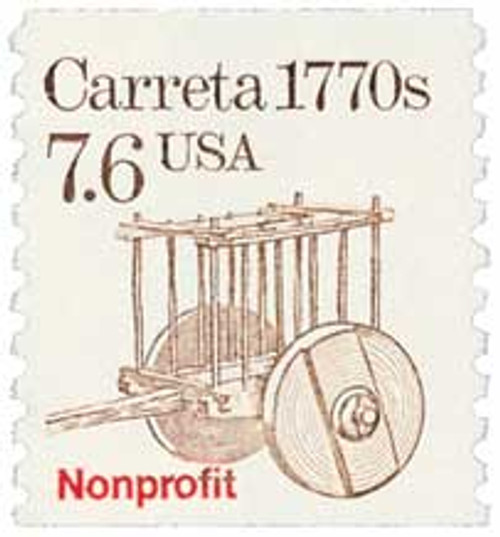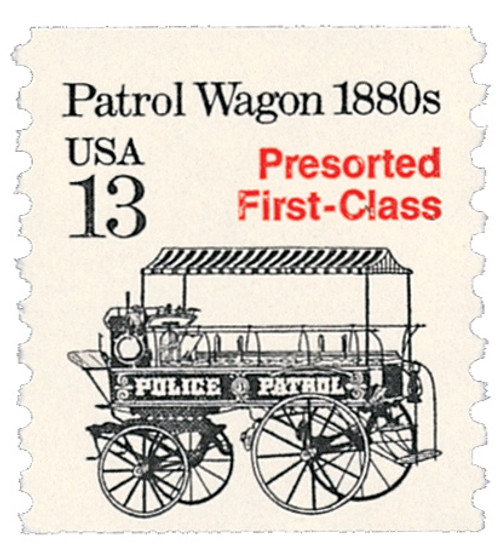
# 2263 - 1988 20c Transportation Series: Cable Car, 1880s
U.S. #2263
1988 20¢ Cable Car, 1880s
Transportation Series
- Pictures a historic San Francisco cable car
- First Transportation stamp with all text at the bottom
Stamp Category: Definitive
Series: Transportation
Value: 20¢, the rate for two-ounce first-class mail
First Day of Issue: October 28, 1988
First Day City: San Francisco, California
Quantity Issued: 53,033,000
Printed by: Bureau of Engraving and Printing
Printing Method: Engraved
Format: Coils of 500 and 3,000
Perforations: 10 Vertical
Color: Blue violet
Why the stamp was issued: This stamp replaced the 1982 20¢ Fire Pumper stamp, paying the postage on the second ounce of first-class mail. Initially, the USPS planned to use this design for a specialized rate with an overprint. However, the BEP said that the elements would be too close together and risk contamination between the inks, creating waste.
About the stamp design: First-time stamp designer Dan Romano created this stamp art from photos provided by the Cable Car Museum in San Francisco. The car pictured is a dummy car, which normally carried the gripman plus a few riders and pulled the rest of the passenger cars. The specific car pictured is No. 46, but that number was removed from the final design. Romano was overall happy with the way the stamp came out, but said it should have been printed in green instead of purple. This stamp was also the first in the series in which all the lettering is at the bottom. According to the USPS, this was because they “wanted to give the effect of a cable car coming up over a hill.”
First Day City: The First Day ceremony for this stamp was held at Union Square in San Francisco. A cable car carried the speakers to the event site.
Unusual fact about this stamp: Over 1,000 imperforate error pairs have been discovered so far.
About the Transportation Series: On May 18, 1981, the USPS issued the first stamp in the Transportation Series, US #1907, picturing the Surrey, a doorless four-wheeled carriage. For the first time in US history, a coil stamp featured its own unique design rather than simply copying that of the current definitive stamp. Over 50 more coil stamps would be issued over the course of the next 15 years, each picturing a different mode of transportation. All of these types of transportation were used since American independence.
The various denominations provided face values to exactly match the rates for several categories of Third-Class mail (bulk rate and quantity-discounted mail). As the rates changed, new stamps with new values were added. Never before had a stamp series included so many fractional cent values.
The Bureau of Engraving and Printing printed most of the stamps in the Transportation Series, although private contractors printed a few. All but a few of the later stamps were produced by engraved intaglio. Differences in precancels, tagging, paper and gum provide a large number of varieties.
Scott Catalog separates the Transportation stamps into four groups. The stamps in the first group (#1897-1908) generally have the denomination in small type with a “c” next to it. These stamps were printed on the Cottrell rotary press, which joined together two plates to make a sleeve. The gaps between these plates created depressions where ink would collect and create joint lines on the stamps. Later issues were printed on a different press and didn’t have these joint lines.
The second group (#2123-36) had larger numbers with no “c.” The third group (#2252-66) was similar in appearance to the second group, but service inscriptions were added to the designs. These stamps also used a variety of paper and gum as well as different types of tagging. The fourth group (#2451-68) marked the end of fractional values. Now bulk mailers would use either the 5¢ or 10¢ stamp and then pay the difference from the actual postage rate.
The last stamp in the Transportation Series, the 20¢ Cog Railway, was issued on June 9, 1995, at the TEXPEX ’95 stamp show in Dallas, Texas. This marked the end of the largest US definitive series up to that time and the largest US coil stamp series in history. Three new series would eventually replace it – American Transportation, American Culture, and American Scenes. Additionally, the Great Americans would go on to become the largest American definitive series.
History the stamp represents: At the turn of the century, cable cars were a common sight in American cities from New York to Seattle. Originally invented by British-born Andrew Hallidie, who felt sorry for the poor horses who struggled to pull streetcars up San Francisco's precipitous grades, these nostalgic cars still take the city's visitors "halfway to the stars."
San Francisco’s First Cable Car
On August 2, 1873, Clay Street Hill Railroad inaugurated San Francisco’s now-famous cable car system.
The city of San Francisco, California, is known for its steep hills. In the early days, horses pulled streetcars up and down the slopes, which was very hard on the animals. British-born San Franciscan Andrew S. Hallidie felt great sympathy for these horses and sought a better way to transport people around the city.
In years prior, attempts at creating a cable-run train had failed in both London and New York, and were eventually replaced with steam locomotives. Hallidie’s work was the manufacture of wire cable, so it was only natural that he invented the cable car as a solution to this problem.
With design assistance from William Eppelsheimer, Hallidie patented his cable car design in 1871. Hallidie’s cable car was propelled by gripping a continuously moving cable that ran under the pavement. Although similar in principle to a ski lift, the cable car was able to connect and remove itself from the line as needed.
Two years later, Hallidie was ready for a trial run. The maiden voyage was held on August 2, 1873. Hallidie operated the cable car himself, down and back up one of the city’s steepest hills with no problem. The 2,791 foot-long track moved the car at just four miles per hour. Passengers took eleven minutes to travel that distance. The world’s first successful cable car line began regular service one month later.
After that first successful run, the number of cable cars increased until they became a symbol of the city. Hallidie’s Clay Street Line would remain in operation until 1942.
Soon cable cars became popular in many cities. Over time, buses and cars have taken over much of their usefulness. However, the steep hills of San Francisco are still traveled by about 40 cable cars on three lines.
U.S. #2263
1988 20¢ Cable Car, 1880s
Transportation Series
- Pictures a historic San Francisco cable car
- First Transportation stamp with all text at the bottom
Stamp Category: Definitive
Series: Transportation
Value: 20¢, the rate for two-ounce first-class mail
First Day of Issue: October 28, 1988
First Day City: San Francisco, California
Quantity Issued: 53,033,000
Printed by: Bureau of Engraving and Printing
Printing Method: Engraved
Format: Coils of 500 and 3,000
Perforations: 10 Vertical
Color: Blue violet
Why the stamp was issued: This stamp replaced the 1982 20¢ Fire Pumper stamp, paying the postage on the second ounce of first-class mail. Initially, the USPS planned to use this design for a specialized rate with an overprint. However, the BEP said that the elements would be too close together and risk contamination between the inks, creating waste.
About the stamp design: First-time stamp designer Dan Romano created this stamp art from photos provided by the Cable Car Museum in San Francisco. The car pictured is a dummy car, which normally carried the gripman plus a few riders and pulled the rest of the passenger cars. The specific car pictured is No. 46, but that number was removed from the final design. Romano was overall happy with the way the stamp came out, but said it should have been printed in green instead of purple. This stamp was also the first in the series in which all the lettering is at the bottom. According to the USPS, this was because they “wanted to give the effect of a cable car coming up over a hill.”
First Day City: The First Day ceremony for this stamp was held at Union Square in San Francisco. A cable car carried the speakers to the event site.
Unusual fact about this stamp: Over 1,000 imperforate error pairs have been discovered so far.
About the Transportation Series: On May 18, 1981, the USPS issued the first stamp in the Transportation Series, US #1907, picturing the Surrey, a doorless four-wheeled carriage. For the first time in US history, a coil stamp featured its own unique design rather than simply copying that of the current definitive stamp. Over 50 more coil stamps would be issued over the course of the next 15 years, each picturing a different mode of transportation. All of these types of transportation were used since American independence.
The various denominations provided face values to exactly match the rates for several categories of Third-Class mail (bulk rate and quantity-discounted mail). As the rates changed, new stamps with new values were added. Never before had a stamp series included so many fractional cent values.
The Bureau of Engraving and Printing printed most of the stamps in the Transportation Series, although private contractors printed a few. All but a few of the later stamps were produced by engraved intaglio. Differences in precancels, tagging, paper and gum provide a large number of varieties.
Scott Catalog separates the Transportation stamps into four groups. The stamps in the first group (#1897-1908) generally have the denomination in small type with a “c” next to it. These stamps were printed on the Cottrell rotary press, which joined together two plates to make a sleeve. The gaps between these plates created depressions where ink would collect and create joint lines on the stamps. Later issues were printed on a different press and didn’t have these joint lines.
The second group (#2123-36) had larger numbers with no “c.” The third group (#2252-66) was similar in appearance to the second group, but service inscriptions were added to the designs. These stamps also used a variety of paper and gum as well as different types of tagging. The fourth group (#2451-68) marked the end of fractional values. Now bulk mailers would use either the 5¢ or 10¢ stamp and then pay the difference from the actual postage rate.
The last stamp in the Transportation Series, the 20¢ Cog Railway, was issued on June 9, 1995, at the TEXPEX ’95 stamp show in Dallas, Texas. This marked the end of the largest US definitive series up to that time and the largest US coil stamp series in history. Three new series would eventually replace it – American Transportation, American Culture, and American Scenes. Additionally, the Great Americans would go on to become the largest American definitive series.
History the stamp represents: At the turn of the century, cable cars were a common sight in American cities from New York to Seattle. Originally invented by British-born Andrew Hallidie, who felt sorry for the poor horses who struggled to pull streetcars up San Francisco's precipitous grades, these nostalgic cars still take the city's visitors "halfway to the stars."
San Francisco’s First Cable Car
On August 2, 1873, Clay Street Hill Railroad inaugurated San Francisco’s now-famous cable car system.
The city of San Francisco, California, is known for its steep hills. In the early days, horses pulled streetcars up and down the slopes, which was very hard on the animals. British-born San Franciscan Andrew S. Hallidie felt great sympathy for these horses and sought a better way to transport people around the city.
In years prior, attempts at creating a cable-run train had failed in both London and New York, and were eventually replaced with steam locomotives. Hallidie’s work was the manufacture of wire cable, so it was only natural that he invented the cable car as a solution to this problem.
With design assistance from William Eppelsheimer, Hallidie patented his cable car design in 1871. Hallidie’s cable car was propelled by gripping a continuously moving cable that ran under the pavement. Although similar in principle to a ski lift, the cable car was able to connect and remove itself from the line as needed.
Two years later, Hallidie was ready for a trial run. The maiden voyage was held on August 2, 1873. Hallidie operated the cable car himself, down and back up one of the city’s steepest hills with no problem. The 2,791 foot-long track moved the car at just four miles per hour. Passengers took eleven minutes to travel that distance. The world’s first successful cable car line began regular service one month later.
After that first successful run, the number of cable cars increased until they became a symbol of the city. Hallidie’s Clay Street Line would remain in operation until 1942.
Soon cable cars became popular in many cities. Over time, buses and cars have taken over much of their usefulness. However, the steep hills of San Francisco are still traveled by about 40 cable cars on three lines.



















